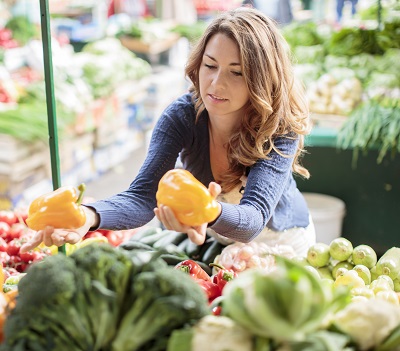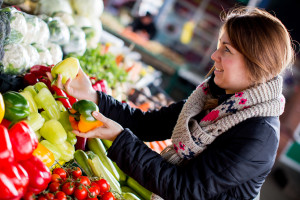- Calls to this hotline are currently being directed to Within Health, Fay or Eating Disorder Solutions
- Representatives are standing by 24/7 to help answer your questions
- All calls are confidential and HIPAA compliant
- There is no obligation or cost to call
- Eating Disorder Hope does not receive any commissions or fees dependent upon which provider you select
- Additional treatment providers are located on our directory or samhsa.gov
Learning How to Grocery Shop for Your Family in ED Recovery

Contributor: Carrie A. Decker, Naturopathic physician
Before and after recovery there are many activities that are seemingly mundane tasks for some people but are much more monumental for individuals who have experienced an eating disorder. Among them are going out to eat, family reunions, buffet style meals, and things such as grocery shopping. Doing what you can to prepare for these events by having a recovery mentor, therapist, or nutritionist to talk to can definitely help.
There also are a variety of eating disorder recovery facilities or groups which have events like this open to people in the community so one can practice these activities in a safer setting amongst others who also experience similar struggles. Looking for something like this in your community or even organizing it if it currently does not exist are ways you can support yourself (and others!) in the healing and recovery process.
Grocery shopping can be a challenging experience in eating disorder recovery both for one’s self but also when shopping for a family. Everyone has their own individual challenges surrounding this which may include cost and availability of foods, fear foods, food label struggles, and food allergies to name a few. In some ways these issues exist for others in the world as well as it is difficult to be certain what ingredients are safe, particularly for individuals with severe allergies and Celiac disease.
Always Make a List
 One of the things which can help anyone in a grocery store is making a list. Just a simple list of what is needed for the week or month or certain recipes can help you to not get stuck in the process in the grocery store. With a list you can simply find an ingredient, put it in the cart, and check it off the list. No need to hem and haw about if you should get it or not – it is on the list and therefore you don’t need to put further thought into it.
One of the things which can help anyone in a grocery store is making a list. Just a simple list of what is needed for the week or month or certain recipes can help you to not get stuck in the process in the grocery store. With a list you can simply find an ingredient, put it in the cart, and check it off the list. No need to hem and haw about if you should get it or not – it is on the list and therefore you don’t need to put further thought into it.
For individuals with families or dependants that they shop for this can go a step further as other people can put their special requests on the list for you to also purchase. Children may be allowed one or two “treat” type items for the week, and can put their selected favorites on your list as well. If the question of what to make for meals is a struggle, a list type option for this where family members can put in votes will help make these decisions more straight forward once you are in the store.
The compulsion to read labels can be a challenge for some in the grocery store. Whether it is a fear about calorie and fat content or other phobias pertaining to ingredients, the draw to read the labels and obsess around what it says and whether or not a food should be purchased can be overwhelming to some people. This is where the previously made list can be helpful – if it item was on the list you just put it in the cart and get along on your way.
From a healthy perspective, shopping the periphery of the grocery store can help everyone to make better food choices – the majority of foods which we actually need such as produce, meat, diary, and eggs are found on the exterior. By selecting the majority of foods from this area the majority of nutritional needs can be met without an excess of processed and artificial ingredients.
Choose to Eat Organic / Non-organic
 The choice to eat foods that are or are not organic (local, hormone-free, etc) can be a challenge for some as well. There are a variety of ways of approaching this. One way to help yourself select between organic and non-organic can be to determine a financial threshold that you are willing to pay for an organic item. As an example you may wish to determine that you are willing to pay 25% more for an organic item than a non-organic counterpart.
The choice to eat foods that are or are not organic (local, hormone-free, etc) can be a challenge for some as well. There are a variety of ways of approaching this. One way to help yourself select between organic and non-organic can be to determine a financial threshold that you are willing to pay for an organic item. As an example you may wish to determine that you are willing to pay 25% more for an organic item than a non-organic counterpart.
If the organic item is more than this cost increase, you select the lower cost alternative. For many people buying a higher quality egg may raise the overall cost of groceries by a dollar or two, but buying organic broccoli can increase costs by $4 especially if it is out of season. There are many reasons why one may chose to eat foods that are organic, hormone-free, or local, and considering these but not having them be an absolute requirement will help you to find the best balance for your own health.
Choose Family Friendly Checkout Aisles
 Finally, getting through the checkout aisle in the grocery can be an additional struggle for some. If it is not the potential impulse buy of a candy item, the tabloids and magazines can be overwhelming. Fortunately none of them actually contain any material that is important or necessary for life, so you actually don’t need to pick them up ever. Many groceries now contain “child-safe” aisles which mean that they don’t have candy or other unnecessary items which can lead to last minute struggles.
Finally, getting through the checkout aisle in the grocery can be an additional struggle for some. If it is not the potential impulse buy of a candy item, the tabloids and magazines can be overwhelming. Fortunately none of them actually contain any material that is important or necessary for life, so you actually don’t need to pick them up ever. Many groceries now contain “child-safe” aisles which mean that they don’t have candy or other unnecessary items which can lead to last minute struggles.
The grocery self-checkout lines also are often a safe alternative as they are less structured and usually don’t have these items either. Finding a grocery store which puts less of this material out also is an option – the smaller neighborhood market or co-op usually will have less of these types of things.
All-in-all, there are many things which one can do to address the challenges they have with a grocery store like many others. Taking time to see what your struggles are with this and addressing them on an individual basis will help you to connect more with your personal feelings and to have your needs met. And like many of the other challenges in recovery, it is something which you will have many opportunities to try!
So if something doesn’t go well one day you can take and learn from this experience and make changes the next time. Although it may seem hugely significant just like other food-related things, in the grand scheme of things it is relatively minor. Stepping back and seeing the parts of your recovery in a larger perspective will help take the magnifying glass off the smaller parts of the whole. By doing such one is much more able to grow!
Community Discussion – Share your thoughts here!
What steps do you take to prepare for grocery shopping and meal preparation for the week in order to support your recovery?
 About the Author: Dr. Carrie Decker is a board-certified naturopathic physician with the North American Board of Naturopathic Examiners, graduating with honors from the National College of Natural Medicine in Portland, Oregon. Dr. Decker works with clients locally in Wisconsin as well as distant regions via telemedicine (Skype or phone) services.
About the Author: Dr. Carrie Decker is a board-certified naturopathic physician with the North American Board of Naturopathic Examiners, graduating with honors from the National College of Natural Medicine in Portland, Oregon. Dr. Decker works with clients locally in Wisconsin as well as distant regions via telemedicine (Skype or phone) services.
To find out more about Dr. Decker or naturopathic medicine, visitwww.BlessedThistle.info or call 608.620.5831.
The opinions and views of our guest contributors are shared to provide a broad perspective of eating disorders. These are not necessarily the views of Eating Disorder Hope, but an effort to offer discussion of various issues by different concerned individuals.
We at Eating Disorder Hope understand that eating disorders result from a combination of environmental and genetic factors. If you or a loved one are suffering from an eating disorder, please know that there is hope for you, and seek immediate professional help.
Last Updated & Reviewed By: Jacquelyn Ekern, MS, LPC on January 3, 2016
Published on EatingDisorderHope.com

The EatingDisorderHope.com editorial team comprises experienced writers, editors, and medical reviewers specializing in eating disorders, treatment, and mental and behavioral health.

